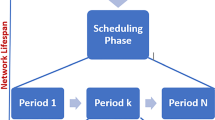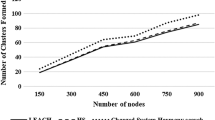Abstract
Increasing the lifetime of heterogeneous wireless sensor network (WSN) and minimizing the run time using improved ACO is an important issue. The computational time is very important in case of such searching algorithms. In this methodology, maximum number of disjoints connected covers are found that fulfill coverage in network and connectivity of the network. A construction graph is designed in which each vertex denotes the a device in a subset. The ants find an optimal path on the construction graph which maximizes the number of connected covers based on pheromone and also heuristic information. The connected covers are built by the pheromone and it is used in the searching. The heuristic information satisfies the desirability of device assignment. The proposed metaheuristic approach is to maximize network lifetime and minimize the computational time for the searching process satisfying both sensing coverage and network connectivity.
Access this chapter
Tax calculation will be finalised at checkout
Purchases are for personal use only
Preview
Unable to display preview. Download preview PDF.
Similar content being viewed by others
References
Zhong, J.-H., Zhang, J.: Ant colony optimization algorithm for lifetime maximization in wireless sensor network with mobile sink. In: Fourteenth International Conference on Genetic and Evolutionary Computation Conference, ACM (2012)
Wang, X., Han, S., Wu, Y., Wang, X.: Coverage and Energy Consumption Control in Mobile Heterogeneous Wireless Sensor Networks. IEEE Transactions on Automatic Control 58(4) (April 2013)
Singh, A., Behal, S.: “Ant Colony Optimizationfor Improving NetworkLifetime in Wireless Sensor Networks. An International Journal of Engineering Sciences 8 (June 2013) ISSN: 2229-6913
Yong-Hwan, et al.: Lifetime maximization considering target coverage and connectivity in directional image/video sensor networks. The Journal of Supercomputing, 1–18 (2013)
Tian, H., Shen, H., Matsuzawa, T.: Random walk routing for wireless sensor networks. Parallel and Distributed Computing, Applications and Technologies. In: PDCAT 2005 (2005)
Wang, X., Wang, X., Zhao, J.: Impact of mobility and heterogeneity on coverage and energy consumption in wireless sensor networks. In: 2011 31st International Conference on IEEE Distributed Computing Systems, ICDCS (2011)
Bai, F., Helmy, A.: A survey of mobility models. Wireless Adhoc Networks. University of Southern California, USA 206 (2004)
Kurose, J., Lesser, V., de Sousa e Silva, E., Jayasumana, A., Liu, B.: Sensor Networks Seminar, CMPSCI 791L, University of Massachusetts, Amherst, MA (Fall 2003)
Srikanth, Umarani, G., Akilandeswari, M.: Computational Intelligence Routing For LifetimeMaximization in Heterogeneous Wireless Sensor Networks. International Journal of Recent Technology and Engineering (2012) ISSN: 2277-3878
Sanjeev, W., Prasad, R.: Heuristic Clustering for Wireless Sensor Networks using Genetic Approach. IJWAMN,International Journal of Wireless and Mobile Networking 1(1) (November 2013s)
Wagh, S., Prasad, R.: Energy Optimization in Wireless Sensor Network through Natural Science Computing: A Survey. Journal of Green Engineering 3(4), 383–402 (2013)
Author information
Authors and Affiliations
Corresponding author
Editor information
Editors and Affiliations
Rights and permissions
Copyright information
© 2015 Springer International Publishing Switzerland
About this paper
Cite this paper
Bhende, M., Patil, S., Wagh, S. (2015). Lifetime Maximization in Heterogeneous Wireless Sensor Network Based on Metaheuristic Approach. In: Satapathy, S., Biswal, B., Udgata, S., Mandal, J. (eds) Proceedings of the 3rd International Conference on Frontiers of Intelligent Computing: Theory and Applications (FICTA) 2014. Advances in Intelligent Systems and Computing, vol 328. Springer, Cham. https://doi.org/10.1007/978-3-319-12012-6_84
Download citation
DOI: https://doi.org/10.1007/978-3-319-12012-6_84
Publisher Name: Springer, Cham
Print ISBN: 978-3-319-12011-9
Online ISBN: 978-3-319-12012-6
eBook Packages: EngineeringEngineering (R0)




